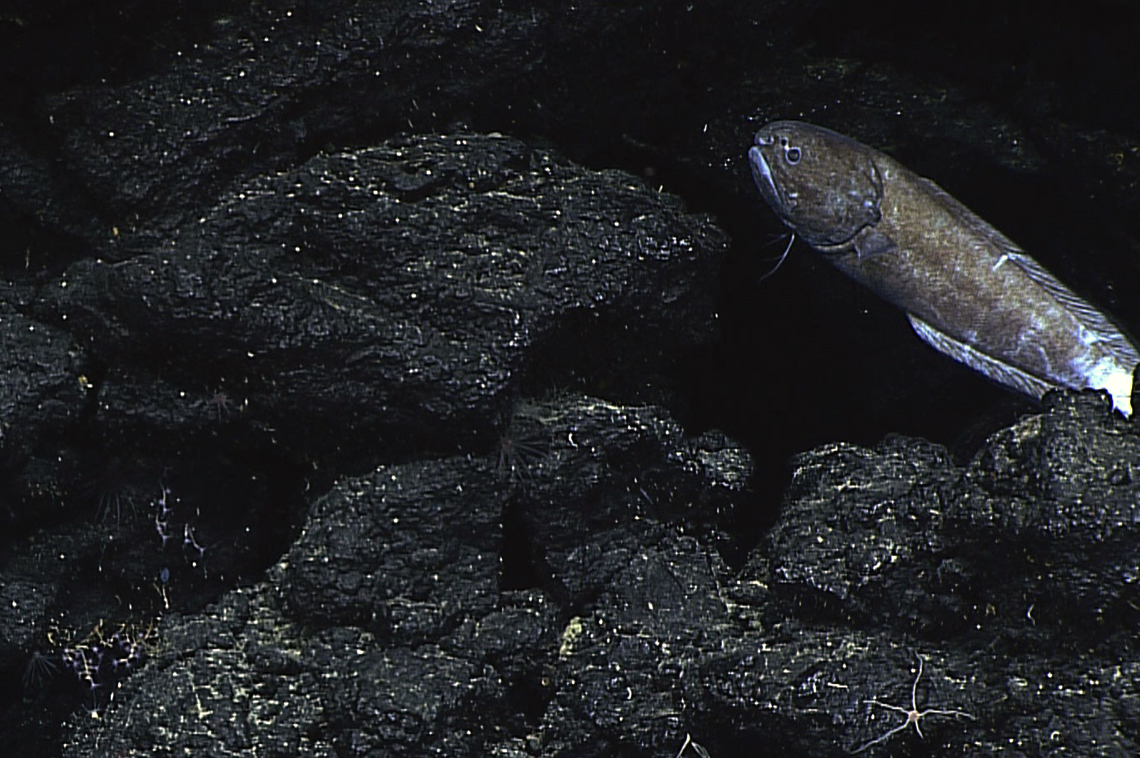Needletooth Cusk, Epetriodus freddyi Cohen & Nielsen 1978

A Needletooth Cusk, Epetriodus freddyi. Source: NOAA Okeanos Explorer / NOAA Office of Ocean Exploration and Research. License: Public Domain
Summary:
A pale brown cusk eel with the head relatively darker than body, dark brown pectoral fins with a pale anterior part, other fins dark brown, the rear portion of the gill cover and abdomen dark blue.
The Needletooth Cusk has a relatively short body, the eye diameter much shorter than the snout, the mouth ending well behind the eye, many needle-like teeth in the jaws, a short, sharp opercular spine, and two median basibranchial tooth patches
The Needletooth Cusk has a relatively short body, the eye diameter much shorter than the snout, the mouth ending well behind the eye, many needle-like teeth in the jaws, a short, sharp opercular spine, and two median basibranchial tooth patches
Cite this page as:
Bray, D.J. 2022, Epetriodus freddyi in Fishes of Australia, accessed 06 Jul 2025, https://fishesofaustralia.net.au/home/species/3014
Needletooth Cusk, Epetriodus freddyi Cohen & Nielsen 1978
More Info
|
Distribution |
South-west of Shark Bay to off Point Cloates, Western Australia. Elsewhere the species occurs in the Indo-west-central Pacific: East and South Africa, eastwards to Wallis and Futuna, north to southern Japan, south to western Australia and New Caledonia. |
|
Features |
Dorsal fin 93–98; Anal fin 72– 78; Pectoral fin 24–29, rays fully joined by membranes; Pelvic fin 2, filamentous; Caudal fin 8; Vertebrae 12–13 + 39–42 = 52–54; Gill rakers, long rakers on first arch 21–23. Body relatively short, eye small (diameter about half snout length), jaws, vomer and palatines with needle-like teeth; two median basibranchial tooth patches; opercular spine short, sharp; fourth and fifth vertebral centra modified with a lower projection. |
|
Etymology |
The species is named for Professor N. B. (Freddy) Marshall in recognition of his contributions to knowledge of the biology of deepsea fishes. |
|
Species Citation |
Epetriodus freddyi Cohen & Nielsen 1978, National Marine Fisheries Service (U.S.). Technical Report 417: 30, fig. 45. Type locality: Southwestern Indian Ocean, 21°18'S, 36°18'E, depth 1510-1600 m. |
|
Author |
Bray, D.J. 2022 |
|
Resources |
Needletooth Cusk, Epetriodus freddyi Cohen & Nielsen 1978
References
Cohen, D.M. & Nielsen, J.G. 1978. Guide to the identification of genera of the fish order Ophidiiformes with a tentative classification of the order. National Marine Fisheries Service (U.S.). Technical Report 417: 1-72 figs 1-103 See ref online
Nielsen, J.G., Cohen, D.M., Markle, D.F. & Robins, C.R. 1999. Ophidiiform Fishes of the World. An annotated and illustrated catalogue of pearlfishes, cusk-eels, brotulas and other ophidiiform species known to date. FAO Fisheries Synopsis No. 125 Vol. 18. 178 pp.
Nielsen, J.G. & Cohen, D.M. 1986. Family No. 96: Ophidiidae. pp. 345-350 in Smith, M.M. & Heemstra, P.C. (eds). Smith's Sea Fishes. Johannesburg : Macmillan South Africa xx + 1047 pp. 144 pls.
Nielsen. J.G. 1999. Families Carapidae, Ophidiidae, Bythitidae, Aphionidae. pp. 1978-1985 in Carpenter, K.E. & Niem, V.H. (eds). The Living Marine Resources of the Western Central Pacific. FAO Species Identification Guide for Fisheries Purposes. Rome : FAO Vol. 3 pp. 1397-2068.
Uiblein, F., Everett, B., Matiku, P. & Sithole, Y. 2020. Epetriodus freddyi. The IUCN Red List of Threatened Species 2020: e.T137521266A137522368. https://dx.doi.org/10.2305/IUCN.UK.2020-1.RLTS.T137521266A137522368.en. Accessed on 07 October 2022.
Williams, A., Last, P.R., Gomon, M.F. & Paxton, J.R. 1996. Species composition and checklist of the demersal ichthyofauna of the continental slope off Western Australia (20-35°5). Records of the Western Australian Museum 18: 135-155.



